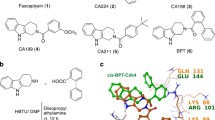Abstract
The compound 1069C85, methylN-[6-(3,4,5-trimethoxybenzyloxy)imidazo(1,2b)-pyridazin-2-yl] carbamate, is a novel synthetic tubulin binder currently undergoing phase I clinical trial. It was developed with a view to overcoming multidrug resistance and is given orally. Cytotoxicity studies in vitro against human ovarian carcinoma cell lines showed a lack of cross-resistance with cisplatin and no cross-resistance in two doxorubicin-resistant cell lines that exhibit high levels of resistance to both paclitaxel and vinblastine. Pharmacokinetic studies in BALB/c mice showed the oral biovailability to be 20%, with 35% of the drug being excreted unchanged in the faeces over the first 24 h. Maximal plasma concentrations (Cmax) were achieved within 2 h of oral administration as compared with 7.5 min following i.v. injection. At a dose of 20 mg/kg, the tumour drug concentration exceeded the plasma Cmax by a factor of 1.5 and was within the in vitro cytotoxic concentration range. The drug showed a linear relationship between the dose and the area under the plasma concentration versus time curve (AUC) for doses of up to 20 mg/kg, above which no further increase in AUC was observed, possibly due to saturable absorption. 1069C85 is highly protein-bound (85%–99%) and appears to be subject to metabolism. The demonstration of cytotoxic activity against multidrug-resistant human tumour cell lines and the detection of potentially cytotoxic levels in an experimental tumour following oral administration support the choice of 1069C85 for clinical development.
Similar content being viewed by others
References
Advanced Ovarian Cancer Trialist Group (1991) Chemotherapy in advanced ovarian cancer: an overview of randomized clinical trials. BMJ 303: 884
Beck WT (1990) Mechanisms of multidrug resistance in human tumor cells. The roles of P-glycoprotein. DNA topoisomerase II, and other factors. Cancer Treat Rev 17: 11
Bissery MC, Bayssas M, Lavelle F (1990) Preclinical evaluation of intraveinous taxotere (RP56976, NSC 628 503), a taxol analog (abstract). Proc Am Assoc Cancer Res 31: 417
Bissery MC, Guenard D, Gueritte-Voeguelin F, Lavelle F (1991) Experimental activity of taxotere (RP 56 976 NSC 628503), a taxol analogue. Cancer Res 51: 4845
Chabner BA (1991) Taxol. In: De Vita VT Jr, Hellman S, Rosenberg SA (eds) Principles and practice of oncology, vol 5, ch 9. J. B. Lippincott, Philadelphia, pp 1–10
Coley HM, Workman P, Twentyman PR (1991) Retention of activity by selected anthracyclines in a multidrug resistant human large cell lung carcinoma line without P-glycoprotein hyperexpression. Br J Cancer 63: 351
Dalton WS, Grogan TM, Ribski JA, Scheper RJ, Richter L, Kailey J, Broxterman HJ, Pinedo HM, Salmon SE (1989) Immunohistochemical detection and quantitation of P-glycoprotein in multiple drug resistant human myeloma cell: association with level of drug resistance and drug accumulation. Blood 73: 747
Danks MK, Yalowich JC, Beck WT (1987) Atypical multidrug resistance in human leukaemic cell lines selected for resistance to teniposide. Cancer Res 47: 11
Goldstein VJ, Galski H, Fojo A, Willingham M, Lai SL, Gazdar A, Pirker R, Green A, Crist W, Brodeur GM, Lieber M, Cossman J, Gotessman MM, Pastan I (1989) Expression of multidrug resistance gene in human cancers. J Natl Cancer Inst 81: 116
Guerrite-Voegelein F, Guernard D, Lavelle F, Le Goff MT, Mantagal L, Potier P (1991) Relationship between the structure of taxol analogues and their antimitotic activity. J Med Chem 34: 992
Hodgson ST, Jenkins DC, Knick V, Rapson EB, Watts SDM (1992) Synthetic and biological properties of 1069C: a new synthetic antitumour agent with very low cross resistance potential. Med Chem Lett 10: 1257
Horwitz SB, Lothstein L, Manfredi JJ, Mellado W, Parness J, Roy SN, Schiff PB, Sorbara L, Zeheb R (1986) Taxol: mechanism of action and of resistance. Ann NY Acad Sci 466: 733
Keeper YP, Piazo PE, Peters GF, Ark-Otte J, Winograd B, Pinedo HM (1991) Comparison between the sulforhodamine B protein and tetrazolium (MTT) assays for in vitro chemosensitivity testing. Eur J Cancer 27: 897
Kelland LR, Abel G (1992) Comparative in vitro cytotoxicity of taxol and taxotere against cisplatin-sensitive and-resistant human ovarian carcinoma cell lines. Cancer Chemother Pharmacol 30: 444
Kelland LR, Murrer BA, Abel G, Harrap KR (1991) Structure activity relationships in a series of novel platinum (II) and platinum (IV) ammine/amine complexes evaluated against a panel of human ovarian carcinoma cell lines. Cancer Res 52: 822
McGuire WP, Rowinsky EK, Rosenheim NB, Grumbine FC, Ettinger DS, Armstrong DK, Donehower RC (1989) Taxol: a unique antineoplastic agent with significant activity in advanced ovarian epitheliomal neoplasms. Ann Intern Med 111: 273
Raynaud F, Walton M, Judson I (1993) An HPLC assay for the measurement of 1069C85 in biological tissue and fluids. J Chromatogr Biomed Appl 622: 243
Reeve JG, Rabbits PH, Twentyman PR (1990) Non P-glycoprotein mediated multidrug resistance with reduced EGF receptor expression in a human large cell lung cancer cell line. Br J Cancer 61: 851
Roy SN, Horwitz SB (1985) A phosphoglycoprotein associated with taxol resistance in J774 cells. Cancer Res 45: 3856
Schiff PB, Fant J, Horwitz SB (1979) Promotion of microtubule assembly in vitro by taxol. Nature 22: 665
Smith PJ, Morgan SA, Fox ME, Watson JV (1990) Mitoxantrone-DNA binding and the induction of topoisomerase II associated DNA damage in multi-drug resistant small cell lung cancer cells. Biochem Pharmacol 40: 2069
Walton MI, Workman P (1987) Nitroimidazole bioreductive metabolism: quantitation and characterization of mouse tissue benznidazole nitroreductases in vivo and in vitro. Biochem Pharmacol 36: 887
Author information
Authors and Affiliations
Rights and permissions
About this article
Cite this article
Raynaud, F.I., Kelland, L.R., Walton, M.I. et al. Preclinical pharmacology of 1069C85, a novel tubulin binder. Cancer Chemother. Pharmacol. 35, 169–173 (1994). https://doi.org/10.1007/BF00686642
Received:
Accepted:
Issue Date:
DOI: https://doi.org/10.1007/BF00686642




